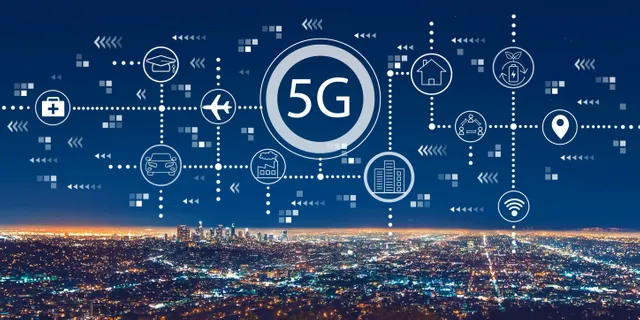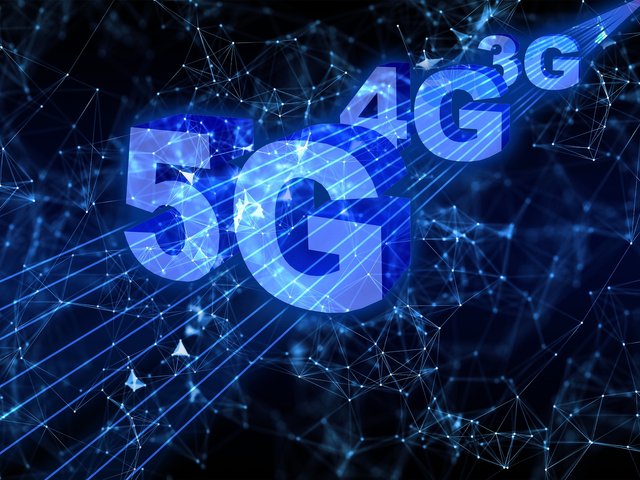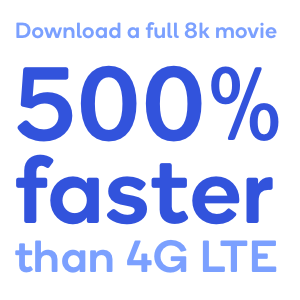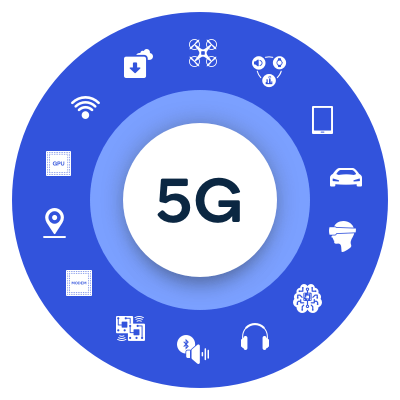Everything you need to know about 5G
Here is where you find 5G technology explained—how 5G works, why 5G is important and how it’s changing the way the world connects and communicates. At Qualcomm, we invented the foundational breakthroughs that make 5G possible.
About 5G mobile network and technology 5th generation
About 5G mobile network and technology 5th generation
Q: What is 5G?
A: 5G is the 5th generation mobile network. It is a new global wireless standard after 1G, 2G, 3G, and 4G networks. 5G enables a new kind of network that is designed to connect virtually everyone and everything together including machines, objects, and devices.
5G wireless technology is meant to deliver higher multi-Gbps peak data speeds, ultra low latency, more reliability, massive network capacity, increased availability, and a more uniform user experience to more users. Higher performance and improved efficiency empower new user experiences and connects new industries.
Q: Who invented 5G?
A: No one company or person owns 5G, but there are several companies within the mobile ecosystem that are contributing to bringing 5G to life. Qualcomm has played a major role in inventing the many foundational technologies that drive the industry forward and make up 5G, the next wireless standard. We are at the heart of the 3rd Generation Partnership Project (3GPP), the industry organization that defines the global specifications for 3G UMTS (including HSPA), 4G LTE, and 5G technologies.
3GPP is driving many essential inventions across all aspects of 5G design, from the air interface to the service layer. Other 3GPP 5G members range from infrastructure vendors and component/device manufacturers to mobile network operators and vertical service providers.
Q: What underlying technologies make up 5G?
A: 5G is based on OFDM (Orthogonal frequency-division multiplexing), a method of modulating a digital signal across several different channels to reduce interference. 5G uses 5G NR air interface alongside OFDM principles. 5G also uses wider bandwidth technologies such as sub-6 GHz and mm Wave.
Like 4G LTE, 5G OFDM operates based on the same mobile networking principles. However, the new 5G NR air interface can further enhance OFDM to deliver a much higher degree of flexibility and scalability. This could provide more 5G access to more people and things for a variety of different use cases.
5G will bring wider bandwidths by expanding the usage of spectrum resources, from sub-3 GHz used in 4G to 100 GHz and beyond. 5G can operate in both lower bands (e.g., sub-6 GHz) as well as mm Wave (e.g., 24 GHz and up), which will bring extreme capacity, multi-Gbps throughput, and low latency.
5G is designed to not only deliver faster, better mobile broadband services compared to 4G LTE, but can also expand into new service areas such as mission-critical communications and connecting the massive IoT. This is enabled by many new 5G NR air interface design techniques, such as a new self-contained TDD subframe design.
Q: What are the differences between the previous generations of mobile networks and 5G?
A: The previous generations of mobile networks are 1G, 2G, 3G, and 4G.
First generation – 1G
1980s: 1G delivered analog voice.
Second generation – 2G
Early 1990s: 2G introduced digital voice (e.g. CDMA- Code Division Multiple Access).
Third generation – 3G
Early 2000s: 3G brought mobile data (e.g. CDMA2000).
Fourth generation – 4G LTE
2010s: 4G LTE ushered in the era of mobile broadband.
1G, 2G, 3G, and 4G all led to 5G, which is designed to provide more connectivity than was ever available before.
5G is a unified, more capable air interface. It has been designed with an extended capacity to enable next-generation user experiences, empower new deployment models and deliver new services.
With high speeds, superior reliability and negligible latency, 5G will expand the mobile ecosystem into new realms. 5G will impact every industry, making safer transportation, remote healthcare, precision agriculture, digitized logistics — and more — a reality.
Q: Where is 5G being used?
A: Broadly speaking, 5G is used across three main types of connected services, including enhanced mobile broadband, mission-critical communications, and the massive IoT. A defining capability of 5G is that it is designed for forward compatibility—the ability to flexibly support future services that are unknown today.
Enhanced mobile broadband
In addition to making our smartphones better, 5G mobile technology can usher in new immersive experiences such as VR and AR with faster, more uniform data rates, lower latency, and lower cost-per-bit.
Mission-critical communications
5G can enable new services that can transform industries with ultra-reliable, available, low-latency links like remote control of critical infrastructure, vehicles, and medical procedures.
Massive IoT
5G is meant to seamlessly connect a massive number of embedded sensors in virtually everything through the ability to scale down in data rates, power, and mobility—providing extremely lean and low-cost connectivity solutions.
Q: How do consumers use 5G?
A: The average consumer is expected use close to 11 GB of data per month on their smartphone in 2022.2 This is driven by explosive growth in video traffic as mobile is increasingly becoming the source of media and entertainment, as well as the massive growth in always-connected cloud computing and experiences.
4G completely changed how we consume information. In the past decade we have witnessed leaps and bounds in the mobile app industry around services such as video streaming, ride sharing, food delivery and more.
5G will expand the mobile ecosystem to new industries. This will contribute to cutting-edge user experiences such as boundless extreme reality (XR), seamless IoT capabilities, new enterprise applications, local interactive content and instant cloud access, to name a few.
Q: How do businesses use 5G?
A: With high data speeds and superior network reliability, 5G will have a tremendous impact on businesses. The benefits of 5G will enhance the efficiency of businesses while also giving users faster access to more information.
Depending on the industry, some businesses can make full use of 5G capabilities, especially those needing the high speed, low latency, and network capacity that 5G is designed to provide. For example, smart factories could use 5G to run industrial Ethernet to help them increase operational productivity and precision.
Q: How fast is 5G?
A: 5G is designed to deliver peak data rates up to 20 Gbps based on IMT-2020 requirements. Qualcomm Technologies’ flagship 5G solutions, the Qualcomm® Snapdragon™ X65 is designed to achieve up to 10 Gbps in downlink peak data rates.
But 5G is about more than just how fast it is. In addition to higher peak data rates, 5G is designed to provide much more network capacity by expanding into new spectrum, such as mmWave.
5G can also deliver much lower latency for a more immediate response and can provide an overall more uniform user experience so that the data rates stay consistently high—even when users are moving around. And the new 5G NR mobile network is backed up by a Gigabit LTE coverage foundation, which can provide ubiquitous Gigabit-class connectivity.
Q: How does 5G work?
A: Like 4G LTE, 5G is also OFDM-based (Orthogonal frequency-division multiplexing) and will operate based on the same mobile networking principles. However, the new 5G NR (New Radio) air interface will further enhance OFDM to deliver a much higher degree of flexibility and scalability.
5G will not only deliver faster, better mobile broadband services compared to 4G LTE, but it will also expand into new service areas, such as mission-critical communications and connecting the massive IoT. This is enabled by many new 5G NR air interface design techniques, such as a new self-contained TDD subframe design.
Q: Does 5G change my home internet service?
A: 5G can change home internet service by providing a wireless modem alternative to existing wires. Internet Service Providers (ISPs) can now serve customers using 5G infrastructure – making the coverage, performance and deployment flexibility of 5G a compelling backhaul alternative to fiber, DSL or cabled solutions.
Q:Is 5G available now?
A: Yes, 5G is already here today, and global operators started launching new 5G networks in early 2019. Also, all major phone manufacturers are commercializing 5G phones. And soon, even more people may be able to access 5G.
5G has been deployed in 60+ countries and counting. We are seeing much faster rollout and adoption compared with 4G. Consumers are very excited about the high speeds and low latencies. But 5G goes beyond these benefits by also providing the capability for mission-critical services, enhanced mobile broadband and massive IoT. While it is hard to predict when everyone will have access to 5G, we are seeing great momentum of 5G launches in its first year and we expect more countries to launch their 5G networks in 2022 and beyond.
Q: Do I need a new phone if I want 5G?
A: Yes, you will need to get a new smartphone that supports 5G if you want to be able to use the network. For example, smartphones powered by the Snapdragon 5G Mobile Platforms are 5G compatible.
There are several new mobile phones available that are designed to support 5G, and multiple carriers across the world support the 5G wireless network. As the 5G rollout timeline progresses, more smartphones and carrier subscriptions will become available, as 5G technology and 5G compatible devices becoming more mainstream.
Sharma Academy UPSC IAS MPPSC Coaching in Indore
Thanks and best regards
Sharma Academy UPSC IAS MPPSC Coaching in Indore
Veda Business Park, G-11, Indore
https://www.sharmaacademy.com/





